Nexus of the Nile - Rural mass transit in Assiut

Students: Franziska Singer, Andrea Grolimund, Tiffany Ker-Sung Wey
This research question starts from a premise that the Nile Valley is a rapidly urbanising condition marked by an increasing population growth and with densities that exceed 2000 people per square kilometre. This high density generates a dense and highly interconnected network of settlements - villages and urban areas - spread along the Valley in.
The question can be raised as to how this unique condition of the dense linear urbanisation creates its own specific systems of transport and flows of people and goods. What types of mobility infrastructures are present and what are the different modalities of transportation? Which parts of this system are provided by the state and which are self-organized?
Until today there is no private involvement in the building of infrastructure and the government is still the sole provider of public infrastructures for the whole country. Various institutional arrangements orchestrate the different hierarchies and types of transportation and infrastructure: for instance, the Ministry of Transport is mainly responsible for the national primary and regional road networks, while the different governorates and the MHUUD (Ministry of Housing, Utilities, and Urban Development) are in charge of developing infrastructure for the local districts and New Towns along the Valley.
The conditions of the road infrastructure are surprisingly good; they are well maintained and street lightning seems omnipresent especially in the new town areas. By contrast, the modalities of public transport seem to decrease strikingly. This imbalance can be traced as a consequence of the neoliberal economic shift in the early 90s, which resulted in shortage of public subsidies in favour of privatisation. This situation is further clarified when looking at the railway system and the public bus system. The Egyptian Railway Authority ERA struggles to keep its existing system in operation, since the fares are heavily subsidized and the railways are frequently lacking in funds. The public bus systems in Egyptian cities are run by separate authorities under control of Governorates, and have been loosing passengers since the 90s due to the rising popularity of private minibuses which operate on fixed routes and ae considered a more reliable mode of collective transportation.

